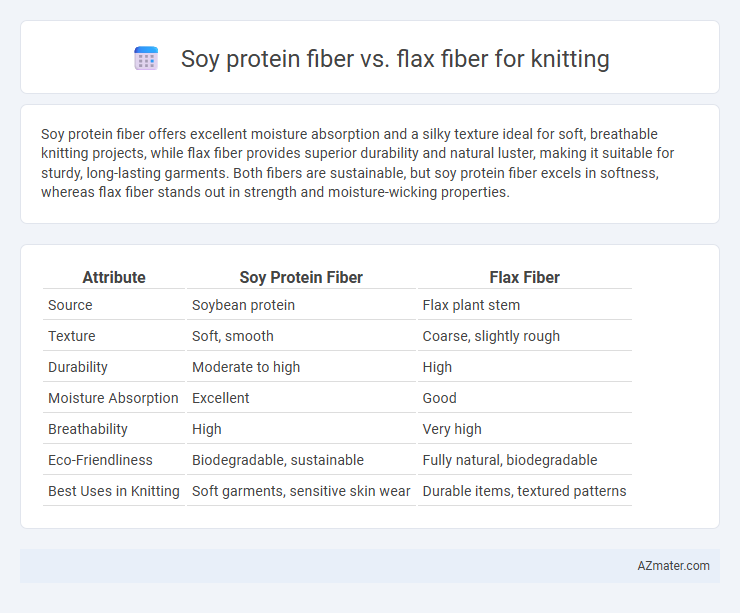Soy protein fiber offers excellent moisture absorption and a silky texture ideal for soft, breathable knitting projects, while flax fiber provides superior durability and natural luster, making it suitable for sturdy, long-lasting garments. Both fibers are sustainable, but soy protein fiber excels in softness, whereas flax fiber stands out in strength and moisture-wicking properties.
Table of Comparison
| Attribute | Soy Protein Fiber | Flax Fiber |
|---|---|---|
| Source | Soybean protein | Flax plant stem |
| Texture | Soft, smooth | Coarse, slightly rough |
| Durability | Moderate to high | High |
| Moisture Absorption | Excellent | Good |
| Breathability | High | Very high |
| Eco-Friendliness | Biodegradable, sustainable | Fully natural, biodegradable |
| Best Uses in Knitting | Soft garments, sensitive skin wear | Durable items, textured patterns |
Introduction to Soy Protein Fiber and Flax Fiber
Soy protein fiber, derived from defatted soybean flakes, offers a soft texture and natural sheen ideal for sensitive skin, while flax fiber, sourced from the flax plant's stem, provides exceptional strength and moisture-wicking properties, making it highly durable for knitting projects. Both fibers are sustainable options; soy protein fiber is biodegradable and promotes breathability, whereas flax fiber is known for its antibacterial qualities and resistance to stretching. Choosing between these fibers depends on the desired balance of softness, durability, and environmental impact in knitting applications.
Origin and Production Processes
Soy protein fiber originates from soybean waste generated during oil extraction, undergoing a process of cleaning, extrusion, and spinning to transform isolated soy proteins into fine, silky fibers suitable for knitting. Flax fiber is derived from the flax plant's stem through retting, drying, and scutching processes that separate the bast fibers, followed by hackling to produce long, strong fibers ideal for textile applications. The sustainable production of soy protein fiber leverages agricultural by-products, while flax fiber production relies on traditional mechanical and biochemical treatments of plant stalks.
Physical Properties Comparison
Soy protein fiber exhibits excellent elasticity and softness, making it highly suitable for knitting projects that require stretch and comfort, while flax fiber is stiffer and more durable, providing superior strength and resistance to wear. Flax fibers have higher moisture-wicking properties and thermal regulation, ideal for lightweight, breathable garments, whereas soy protein fibers tend to retain moisture, offering a silk-like texture with a smooth surface. The durability of flax fiber withstands repeated washing better than soy protein fiber, which may weaken with extensive exposure to water and agitation.
Texture and Feel on Skin
Soy protein fiber offers a smooth, silky texture with excellent softness, making it gentle and comfortable against the skin for knitting projects. Flax fiber, derived from flax plants, has a slightly coarser feel but provides exceptional breathability and durability, ideal for summer garments requiring strong, lightweight fabric. For knitwear emphasizing softness and a luxurious hand, soy protein fiber stands out, while flax fiber excels in moisture-wicking and cooling properties.
Breathability and Moisture Wicking
Soy protein fiber offers excellent breathability and moisture-wicking properties due to its smooth, porous structure, making it ideal for knitting lightweight, comfortable garments. Flax fiber, derived from flax plants, is renowned for its superior moisture absorption and quick-drying abilities, providing natural cooling and breathability in knitted fabrics. Both fibers enhance ventilation and moisture management, but flax tends to outperform soy protein in durability and moisture wicking for active wear knits.
Environmental Impact and Sustainability
Soy protein fiber for knitting offers a biodegradable and renewable alternative derived from soybean processing waste, reducing industrial byproduct pollution. Flax fiber, sourced from flax plants, is highly sustainable due to minimal pesticide use, low water requirements, and natural biodegradability. Compared to flax, soy protein fiber's environmental impact is lower as it utilizes agricultural waste, promoting circular economy principles in textile production.
Dyeability and Color Retention
Soy protein fiber offers superior dyeability compared to flax fiber, absorbing pigments evenly for vibrant and consistent colors in knitting projects. Flax fiber, while naturally durable and breathable, tends to have a more muted color palette with less intense dye absorption and quicker fading over time. Knitters seeking long-lasting, vivid hues often prefer soy protein fiber for enhanced color retention and a soft, smooth texture.
Durability and Longevity in Knitted Garments
Soy protein fiber exhibits moderate durability in knitted garments, offering softness and a smooth texture but tends to wear faster under frequent use compared to flax fiber. Flax fiber, derived from the flax plant, is known for exceptional strength and longevity, maintaining structural integrity and resisting pilling over time in knitwear. Knitted garments made with flax fiber demonstrate superior durability and extended lifespan, making flax a preferred choice for long-lasting textile applications.
Application Suitability in Knitting Projects
Soy protein fiber offers a smooth texture and excellent drape, making it ideal for lightweight, breathable garments such as summer tops and baby clothes in knitting projects. Flax fiber, known for its strength and durability, provides a slightly rougher texture suited for sturdy items like market bags, home decor, and summer sweaters. Choosing between these fibers depends on the desired softness, elasticity, and end-use function in knitting applications.
Choosing the Right Fiber: Key Considerations
Soy protein fiber offers a smooth texture, excellent elasticity, and moisture-wicking properties, making it ideal for soft, comfortable knits with good durability. Flax fiber, derived from the flax plant, is stronger and more breathable, providing a natural luster and superior moisture absorption, which is perfect for lightweight, cool garments. When choosing between soy protein and flax fibers for knitting, consider factors like desired fabric softness, durability, breathability, and moisture management to match the specific garment's function and feel.

Infographic: Soy protein fiber vs Flax fiber for Knitting
 azmater.com
azmater.com